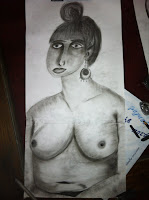
The mythology surrounding beauty, ideal beauty to be exact is inescapable here. Everywhere you turn there are sculptures and paintings depicting what in both the past and present is considered to be “beauty”. This idea of beauty is one of the most noticeable aspects of this country. From the landscapes of seas and sprawling olive fields to the dramatic architecture adorned with paintings and sculptures, all that surrounds me strikes me with a feeling very similar to that of lust. I want to hold it in my mind, photograph, and draw it, to in some way make it tangible, make it more “real” than the reality that lies before me. The image of beauty in my mind is transformed from what I see to encompass a feeling, an unspeakable ideal of what has taken centuries to create and express. I find myself questioning this sensation of what is considered beautiful.
Myth after myth describe the Goddess and Gods, their perfectly toned bodies, their musical talents and warrior mentalities in such a way as to make them the pinnacle of what a perfect human should look and act like. Apollo with his unbeatable musical ability, Aphrodite with her unattainable beauty and charm, Athena and Zeus with their powers of war and protectio
 y? Can they protect me? Fight for me? Create music or dance?” All ideals which have been personified in Greek myth and art. But how real are these standards, how can any mortal ever live up to these kinds of perfection?
y? Can they protect me? Fight for me? Create music or dance?” All ideals which have been personified in Greek myth and art. But how real are these standards, how can any mortal ever live up to these kinds of perfection?
I have talked with some of the most “beautiful” people I know and listened to them all speak of their lack of this “perfection”. From my eyes, they evoke an overwhelming sensation of beauty, but when looked at through their own eyes they see a void, a pedestal unreachable, reserved only for the Goddesses and Gods of today that fill pages of magazines and dominate television and movies. The way I see beauty is by all means influenced by this design of ideal beauty. Every westernized country is filled with advertisements directed at the very impressionable youth, teaching them from a young age what “beauty” is and how to embody it. The more I interact with this ideal the more I begin to see it as a fallacy, almost the opposite of what real beauty is. I have started drawing these people that will never live up to their own idea of beauty. I sit and stare at, what in their minds are imperfections, and think how much character and life these “imperfections” hold. The wrinkles around the eyes, the womanly curves around a belly button, the shadow cast by a breast, all features I focus on and see as the most beautiful, are grounds for plastic surgery, dieting, an

My ideal beauty is life, lived hard with struggles shown in lines on the face and weight around the belly, scares and horns. I find myself photographing and drawing people most wouldn’t give a second look, and finding the most beauty in their “imperfections”.
It is amazing how in a time span of over 3,000 years the stories of the myth of beauty are still the same. Aphrodite, the beautiful, is still the one the boys fight over; Artemis, the virgin, is still trying to be conquered; Hera, the older women, is still being cheated on with younger women; Hephaestus, the lame, is still being ridiculed by his friends and family, and Zeus, almighty man, is still in power. The ideals of the perfect human are still being perpetuated today. Every mainstream television show and movie has the same base of char acters as the mythology surrounding the Greek pantheon of Gods. Only now, rather than watching a play in a beautifully designed outdoor theater, we sit and watch via cable and satellite, being force feed commercials after commercial telling us what “real beauty” is all about; white teeth, flat bellies, long flowing hair, designer jeans and a new car.
acters as the mythology surrounding the Greek pantheon of Gods. Only now, rather than watching a play in a beautifully designed outdoor theater, we sit and watch via cable and satellite, being force feed commercials after commercial telling us what “real beauty” is all about; white teeth, flat bellies, long flowing hair, designer jeans and a new car.
The myth of the ideal human, their beauty and power, have become more than just a myth of the Gods acted out on stage, it has become the impossible reality of a whole society. This myth turned reality is what is driving my artistic choices and catching my attention turning my daily drawings and thoughts into my own version of ideal beauty. I am rewriting the myth of ideal beauty in my mind to create my own version of this age-old myth.








